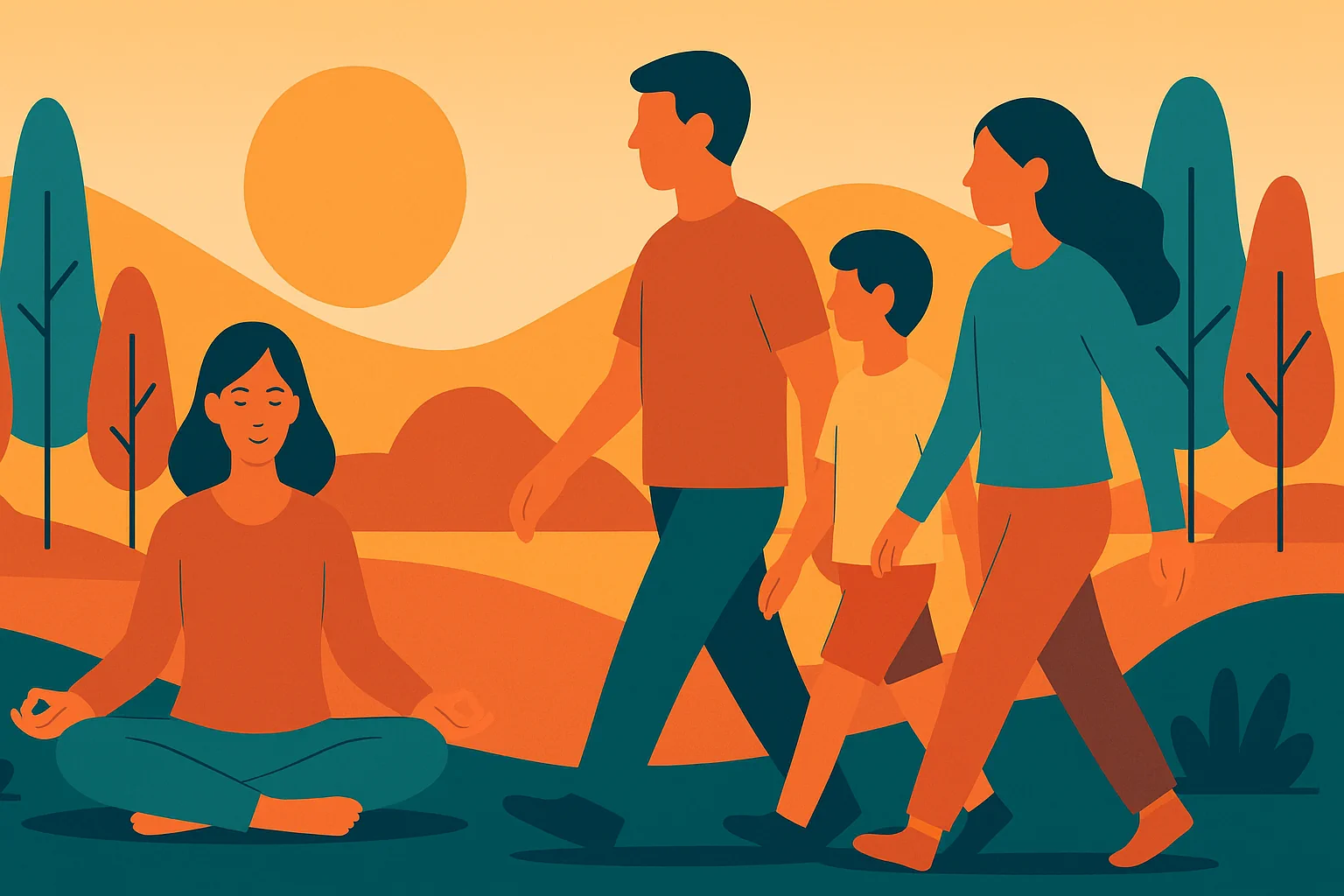At 6:45 a.m., before the kitchen fills with the sound of toast popping and phones buzzing, 14-year-old Ava sits cross-legged on the living-room rug. Her mother, Maya, joins her silently, matching the rhythm of her breath. For five minutes, neither says a word. The timer chimes, and they exchange a small smile — that quiet, post-meditation recognition that for a brief moment, they were both still.
It’s not a scene you would have found in many households two decades ago. Wellness — mindfulness, nutrition, movement, emotional hygiene — used to be an adult pursuit, the realm of gym memberships and self-help books. But today, it’s as likely to show up in a high-school hallway or family group chat as it is in a yoga studio.
Across the world, wellness has become intergenerational. Teenagers are teaching parents how to breathe through anxiety, families are joining wellness retreats together, and schools are hiring “mindfulness coordinators.” This isn’t just a lifestyle trend — it’s a cultural shift, reshaping how we think about health, identity, and even love.
The Rise of Teen Wellness
Scroll through TikTok for five minutes and you’ll find a teenager showing you how to “reset your dopamine” or make a “stress-free smoothie.” Some of it is fluff, sure — but much of it reflects something deeper: a generation that grew up in chaos searching for control.
According to a 2024 Pew Research Center report, over 60% of Gen Z teens say they practice at least one form of self-care weekly, whether it’s journaling, meditation, exercise, or screen-free time. The reasons aren’t superficial — anxiety and burnout have become defining experiences for their age group. The American Psychological Association’s 2024 “Stress in America” report found that 46% of U.S. teens describe their stress levels as “unmanageable,” and more than half worry about the future “most days.”
Wellness, for Gen Z, isn’t a luxury — it’s survival. “This generation doesn’t see therapy or meditation as weird,” says Dr. Melissa Goodman, a child psychologist at the University of Michigan. “They see it as hygiene for the mind — like brushing your teeth.”
From digital detoxes to dopamine breaks, Gen Z’s wellness habits are an act of soft rebellion — a refusal to inherit the chronic exhaustion of their parents. They’ve watched older generations glorify burnout, and they’re saying no.
Wellness as a Language of Connection
For parents, the surprise isn’t that teens are interested in wellness — it’s that they’re leading it. The new dynamic is collaborative rather than top-down. A 2025 survey by the Family Wellness Institute found that in over half of families who practiced regular wellness habits, it was the teenager who initiated them.
Family therapist Dr. Andrea Villegas calls this “reverse mentorship.”
“Parents used to teach kids how to ride bikes or read books,” she says. “Now, kids are teaching parents how to meditate, how to identify burnout, how to name emotions. It’s flipping the script — and it’s beautiful.”
Families who practice wellness together — whether that means Sunday yoga, evening walks, or preparing healthy meals — tend to experience lower reported stress levels and stronger emotional bonds. In a 2024 APA Family Resilience study, families that spent at least 30 minutes daily in shared well-being practices reported 23% fewer conflicts and higher life satisfaction.
At the heart of this movement is mindful presence — the idea that wellness isn’t just about fixing what’s broken, but nurturing what connects us.
Schools Join the Movement
The most dramatic shift, however, is happening where children spend most of their days: in schools.
In Finland, the government recently expanded its Onni Wellbeing Hour, a weekly program built into public schools that integrates mindfulness, emotional regulation, and nutrition education. In the U.K., programs like MindUp for Schools, supported by the University of Oxford, teach mindfulness to over 1 million students annually.
In the United States, dozens of districts are quietly experimenting with “wellness breaks” — short guided pauses between classes. The WHO’s Global School Health Initiative (2024) notes that such interventions have reduced reported stress and improved sleep patterns among students.
“Mindfulness is not about silence — it’s about emotional fluency,” says educator Leah Barnes, who coordinates a wellness curriculum at a California high school. “When students can name what they feel, they can move through it instead of being consumed by it. That’s a lifelong skill.”
These programs don’t replace academics; they support them. The Harvard T.H. Chan School of Public Health found in 2024 that students participating in school-based mindfulness programs had better attention control and improved memory recall — both crucial for learning.
Nutrition, Hormones, and the Growing Brain
Wellness for teens can’t just be emotional — it’s profoundly biological. During adolescence, the brain undergoes a massive neural “remodeling.” Hormones, growth spurts, and sleep cycles are all in flux. Nutrition, sleep, and physical activity become powerful levers for mental health.
Harvard researchers have documented that omega-3 fatty acids, B-vitamins, and adequate protein intake are linked with improved neurotransmitter balance and mood regulation in teens. Meanwhile, the microbiome-brain connection — once fringe science — is now mainstream: studies show that gut diversity correlates with reduced risk of depression and anxiety.
Families that shift together to plant-forward diets or fermented foods (like kefir, kimchi, and yogurt) often see not just physical benefits but emotional regulation improvements. “When a family cooks and eats together, you’re not just feeding bodies — you’re synchronizing rhythms,” says Dr. Miguel Alvarez, a nutritional neuroscientist at the University of Toronto.
Technology: The Double-Edged Coach
The same screens that overwhelm teens are also becoming their wellness companions. AI-driven mindfulness apps, mood trackers, and personalized health dashboards are part of the new landscape.
A 2025 New York Times wellness technology report found that one in three American families now uses at least one AI-based health or mindfulness app. Some apps, like Calm Family and Headspace Teens, allow parents and kids to set joint goals — breathing sessions, gratitude logs, or evening wind-downs.
But technology’s role isn’t without tension. “We have to remember that digital wellness tools are still digital,” warns psychologist Dr. Farah Lin from the APA’s Youth and Tech division. “If mindfulness becomes another metric to optimize, it stops being mindfulness.”
The healthiest families use tech intentionally — as a tool for connection, not surveillance. “We track sleep, not control it,” says Maya, Ava’s mother. “We use the data to notice patterns, not punish them.”
The New Wellness Economy — and Its Risks
Where attention goes, the market follows. The teen wellness sector is booming: from adaptogenic drinks marketed as “calm in a can” to social-media influencers promoting supplements to minors.
The Global Wellness Institute estimates that the youth wellness market surpassed $90 billion in 2024, driven by skincare, supplements, and wearable devices. Yet, experts caution that wellness without literacy can slip into consumerism.
Dr. Emily Sanders, a pediatric endocrinologist, puts it bluntly: “Wellness shouldn’t be another stressor. When 15-year-olds start fasting or taking nootropics they saw on TikTok, we’ve lost the plot.”
Education — not products — remains the antidote. Real wellness literacy means understanding why something works, how to assess evidence, and when to rest instead of optimize.
Family Rituals: Wellness as Belonging
In the families leading this quiet revolution, wellness is less about perfection and more about participation.
Some parents set up “no-phone dinners” where conversation — not content — takes center stage. Others schedule Sunday resets: meal prepping, walks, journaling, or gratitude circles. “It’s our way of hitting pause,” says James, a father of two teens in Chicago. “We don’t always get it right, but those small routines keep us close.”
In families like his, wellness becomes a shared identity, not a rulebook. Children witness their parents being vulnerable — admitting stress, apologizing, breathing deeply. And parents witness their children leading — suggesting meditation playlists or evening stretches.
“Intergenerational wellness,” says Dr. Villegas, “isn’t about who’s in charge. It’s about co-regulation — families learning to calm and grow together.”
The Emotional Legacy
What’s at stake in this movement isn’t just physical health — it’s emotional legacy.
Every generation inherits more than genes. They inherit coping mechanisms, unspoken habits, nervous systems shaped by the environments they grew up in. Gen Z may be the first generation consciously rewriting that inheritance.
When a teenager decides to take a walk instead of doomscrolling, when a parent joins them, that’s more than a habit — it’s a small act of cultural repair. It says: We can live differently. We can choose calm over chaos.
And maybe, in the process, they are healing something older than themselves.
The Future: From Me Wellness to We Wellness
The next chapter of wellness won’t be about biohacking or self-optimization — it will be about coherence. The healthiest families of the next decade will treat wellness as a collective practice: shared meals, shared silence, shared laughter.
“Family wellness,” says Dr. Goodman, “is the new frontier of preventive medicine. When a household regulates together — emotionally, nutritionally, physically — they build resilience that no supplement can buy.”
The future of wellness, then, might look less like a solo pursuit and more like that quiet moment before dawn — a mother and daughter breathing in sync, not because they’re chasing serenity, but because they’ve found it together.
Sources
- Pew Research Center (2024): Teen Digital Health and Wellness Trends.
- https://www.cdc.gov/healthy-youth/mental-health/mental-health-numbers.html
- https://pifonline.org.uk/news/pagb-self-care-census-2024/

